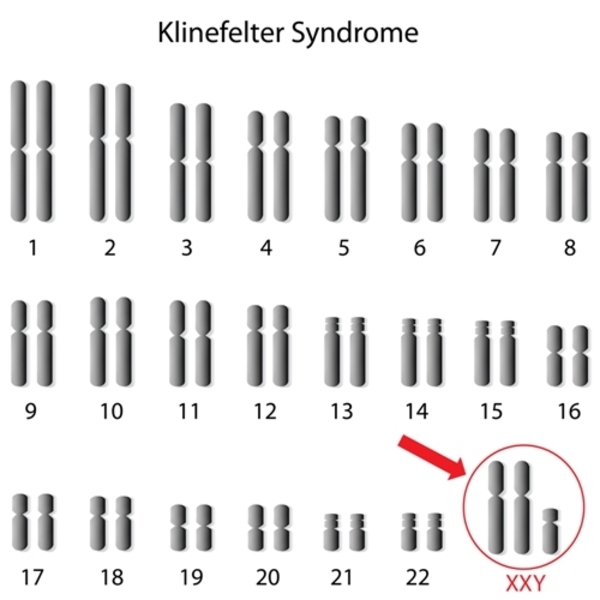Delayed puberty other diagnostic studies: Difference between revisions
No edit summary |
No edit summary |
||
| Line 18: | Line 18: | ||
* The main syndromes which are the cause of delayed [[puberty]], [[Turner syndrome]] and [[Klinefelter syndrome]] can be diagnosed by [[karyotyping]]. | * The main syndromes which are the cause of delayed [[puberty]], [[Turner syndrome]] and [[Klinefelter syndrome]] can be diagnosed by [[karyotyping]]. | ||
* [[Turner syndrome]] is characterized by one single [[X chromosome]] in females, instead of one pair of [[X chromosomes]].<ref name="urlTurner syndrome - Genetics Home Reference">{{cite web |url=https://ghr.nlm.nih.gov/condition/turner-syndrome |title=Turner syndrome - Genetics Home Reference |format= |work= |accessdate=}}</ref> | * [[Turner syndrome]] is characterized by one single [[X chromosome]] in females, instead of one pair of [[X chromosomes]].<ref name="urlTurner syndrome - Genetics Home Reference">{{cite web |url=https://ghr.nlm.nih.gov/condition/turner-syndrome |title=Turner syndrome - Genetics Home Reference |format= |work= |accessdate=}}</ref> | ||
* [[Klinefelter syndrome]] is characterized by two [[X chromosomes]] along with [[Y chromosome]] in males, instead of one [[X chromosome|X]] and one [[Y chromosome|Y chromosomes]]. | * [[Klinefelter syndrome]] is characterized by two [[X chromosomes]] along with [[Y chromosome]] in males, instead of one [[X chromosome|X]] and one [[Y chromosome|Y chromosomes]].<ref name="urlKlinefelter syndrome - Genetics Home Reference">{{cite web |url=https://ghr.nlm.nih.gov/condition/klinefelter-syndrome |title=Klinefelter syndrome - Genetics Home Reference |format= |work= |accessdate=}}</ref> | ||
=== Olfactory function test === | === Olfactory function test === | ||
Revision as of 18:10, 11 September 2017
|
Delayed puberty Microchapters |
|
Diagnosis |
|---|
|
Treatment |
|
Case Studies |
|
Delayed puberty other diagnostic studies On the Web |
|
American Roentgen Ray Society Images of Delayed puberty other diagnostic studies |
|
Risk calculators and risk factors for Delayed puberty other diagnostic studies |
Editor-In-Chief: C. Michael Gibson, M.S., M.D. [1]; Associate Editor(s)-in-Chief: Eiman Ghaffarpasand, M.D. [2]
 |
 |
Overview
In every chromosomal disorder that is leading to delayed puberty, karyotyping is a reliable way of diagnosis. The main syndromes which are the cause of delayed puberty, Turner syndrome and Klinefelter syndrome can be diagnosed by karyotyping. The test, called University of Pennsylvania Smell Identification Test (UPSIT), is consisted of microencapsulated odorants; released by scratching standardized odor-impregnated questionnaires. It is used to detect hyposmia or anosmia in Kallmann syndrome.
Other Diagnostic Studies
Karyotyping
- In every chromosomal disorder that is leading to delayed puberty, karyotyping is a reliable way of diagnosis.
- Karyotyping is the way of direct visualization of human chromosomes in a view.
- The main syndromes which are the cause of delayed puberty, Turner syndrome and Klinefelter syndrome can be diagnosed by karyotyping.
- Turner syndrome is characterized by one single X chromosome in females, instead of one pair of X chromosomes.[1]
- Klinefelter syndrome is characterized by two X chromosomes along with Y chromosome in males, instead of one X and one Y chromosomes.[2]
Olfactory function test
- The test, called University of Pennsylvania Smell Identification Test (UPSIT), is consisted of microencapsulated odorants; released by scratching standardized odor-impregnated questionnaires.
- It is used to detect hyposmia or anosmia in Kallmann syndrome.[3]
References
- ↑ 1.0 1.1 "Turner syndrome - Genetics Home Reference".
- ↑ 2.0 2.1 "Klinefelter syndrome - Genetics Home Reference".
- ↑ Palmert, Mark R.; Dunkel, Leo (2012). "Delayed Puberty". New England Journal of Medicine. 366 (5): 443–453. doi:10.1056/NEJMcp1109290. ISSN 0028-4793.